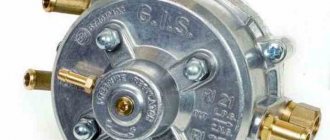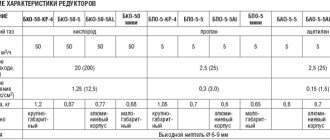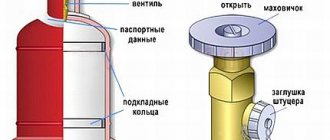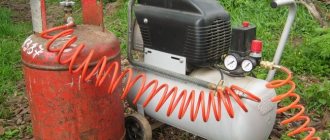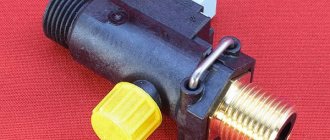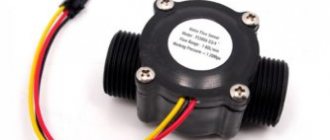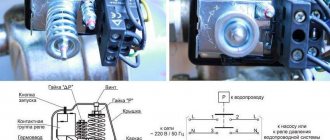Not all settlements and dacha areas are connected to the centralized gas supply. Unfortunately, there are still towns and villages in which bottled gas is actively used. For its safe use, a gas reducer is required - a device that reduces the fuel pressure to the values required for stoves and boilers.
We will tell you everything about the guidelines for choosing a reduction device. The information we provide will help you buy the most suitable reducer for installation on a gas cylinder. We describe in detail the types of devices and the criteria according to which preference should be given to a particular model.
Those wishing to independently install and connect the reduction device will be helped by the detailed step-by-step instructions. Here you will find rules, compliance with which will protect you and extend the service life of gas installations. The article is illustrated with photographs and supplemented with video tutorials.
Classification depending on the scope of application
Depending on the scope of application, reducers for gas cylinders are divided into several types:
- Household unregulated.
- Universal adjustable
- Professional.
Household unregulated
This type includes the simplest gearboxes used in domestic gas supply to households and in camping conditions. RDSG reducers are installed together with household gas cylinders. They have the simplest design, allowing the use of gas only in household stoves and are inexpensive and reliable. The frog reducer for a gas cylinder, or RDSG-1, is used in conjunction with containers from 12 to -50 liters.
For five-liter gas cylinders, popular among summer residents, tourists and hunters, the RDSG-2 Baltika model is used. The Baltika reducer is put on the nipple of the gas cylinder from above and fixed in the rubber seal with a special clamp. The gearboxes are configured for an operating pressure of 0.3 MPa and a throughput of 1.2 m 3 / hour
Universal adjustable
This class of gearboxes has a more complex design and wider capabilities. They can already be used both for domestic gas supply and for work in a home workshop. These reducers have a mandatory threaded connection to the gas cylinder, which securely locks the device.
Universal adjustable for propane with pressure gauge
They are also equipped with a pressure gauge and an adjusting screw that allows you to change the operating pressure from 0 to 0.3 MPa, depending on the needs of the gas consumer device connected to them. These devices also have a greater throughput than household ones - up to 5 m 3 / hour
Professional
This class is characterized by the use of more wear-resistant materials and better build quality and adjustment. The operating pressure adjustment parameters are also wider – from 0.4 to 1.6 MPa.
Professional gearbox with two pressure gauges
Some models are equipped with two pressure gauges - for inlet and operating pressure, respectively.
Pressure regulator RDSG 2-1.0 "Baltika"
By design, Baltika type regulators are direct-acting. They are simple and easy to use. They should be purchased separately, unlike valves that are pre-installed on cylinders and sold together with them. For several replaceable cylinders, it is enough to have one regulator (Fig. 1-10-3a).
Rice. 1-10-3a. Gas pressure regulators RDSG 2-1.0 (Baltika) with a valve on the cylinder:
1 - handle; 2 - fitting; 3 - rubber sealing ring; 4 - valve; 5 — threaded bushing of the cylinder;
The regulator is connected to household gas appliances using a rubber-fabric sleeve with an internal diameter of 10 mm.
When installing the regulator on the valve, the tap handles of the household gas appliance (most often a gas stove) connected to the regulator are set to the “Closed” position. The rubber-fabric sleeve connecting the household gas appliance to the regulator is pressed onto the regulator fitting with a metal clamp.
The regulator handle is turned to the “closed” position and the regulator is placed on the valve of a cylinder filled with gas. To do this, cover the regulator with your palms and press the plastic ring up with your fingers, place the regulator on the valve, lower the ring with force until it stops so that the balls move and catch on the protrusion on the valve. In this case, there must be a rubber sealing ring between the regulator and the valve.
The regulator handle is moved to the “Open” position (the image of the flame on the handle will be on top) and the tightness of the connection between the regulator and the rubber-fabric sleeve and the valve is checked by washing.
If there are no leaks, open the tap and light the burner of the gas appliance.
After the operation of the gas appliance ends, the handles of the regulator and taps are moved to the “Closed” position. During long breaks in use (more than 4-5 hours) of a gas appliance, the regulator handle is moved to the “Closed” position (with the taps of the gas appliance closed).
To remove the regulator from the cylinder valve, press up the plastic ring and lift the regulator by the body.
If the regulator is inactive for a long time, it is better to disconnect it from the cylinder valve, move the handle to the “Open” position, and lightly lubricate the balls.
If washing shows a gas leak from under the regulator, then its handle is moved to the “Closed” position (with the gas appliance taps closed) and the regulator is removed from the valve. Then take the cylinder with the valve out of the room and repeat washing the valve itself. If a gas leak is detected from the valve, you should call a specialist or, taking precautions, deliver the cylinder with the valve to the charging point.
- use a faulty regulator and repair it yourself; install the regulator on the valve and remove it if the handle is in the “Open” position and the taps of household gas appliances are not closed (in the “Open” position, the protruding rod of the regulator will press on the valve locking device, and gas will escape into the room);
- mount the regulator on the valve if there is no rubber sealing ring between them, and if there are circular holes or cracks on the ring;
- carry out independent valve repairs even on an empty cylinder, as residual gas vapors will be released from it.
Source
Features of using composite gas cylinders
Composite gas cylinders have recently become increasingly popular. This is due to their advantages over their steel counterparts.
- Weight. Almost twice as light as steel.
- Ease of handling. There are comfortable handles.
- Transparency. The fill level can be easily seen.
- Convenient storage. Can be placed one on top of the other and stacked.
- Life time. The service life is practically unlimited.
- Operational safety. It is caused by the absence of sparking and a safety valve and fusible link built into the gas cylinder.
Composite cylinders supplied to the Russian market are produced in the Czech Republic, Norway and India. When purchasing such a cylinder, it is necessary to clarify the connection standard. If the gas cylinder is equipped according to the Russian standard, you can use a regular reducer for the gas cylinder. If the gas cylinder comes with a European connector, then you will need to either order an adapter or purchase an imported reducer. Please note that each additional connection increases the risk of gas leakage.
What is a propane reducer?
The design of all propane reducers is very similar. They all have:
- Sealed housing made of aluminum, brass or plastic.
- Inlet pipe for connection to the cylinder.
- Outlet pipe for connection to the consumer.
- High and low pressure chambers.
- Flexible membrane.
- Valve and stem.
- Return spring.
- Working spring.
In professional gas reducers, a pressure gauge, an adjusting screw or flywheel, and a threaded connection of the supply pipe are added to the design. The gearbox housing has a cylindrical shape, which is due to the use of a round membrane that bends inside the operating pressure chamber. The inlet and outlet pipes protrude from the housing.
The main causes of gearbox hum
So what could be causing the gearbox hum, and is it dangerous? Now that we understand the principle of operation of the device, this question can be answered as follows:
- With the membrane moving from its working position. Most often, this malfunction occurs when the membrane is installed incorrectly; it can be treated by simply overhauling the gearbox;
- With wear on the rubber parts of the valve. A problem that can be unpleasant when the reducer continues to release portions of gas into the working area, and if the gas equipment is not sealed, gas contamination may occur in the room;
- With a membrane rupture. The most common cause of hum, a secondary symptom is a discrepancy between the output pressure and that declared by the manufacturer. Corrected by replacing the membrane with a new one;
- With a hose split at the inlet fitting. The problem is solved by replacing the hose. The main danger is depressurization of equipment;
- Poor quality fuel. This is also one of the reasons when an unpleasant hum may be observed in the gearbox area. As a rule, it occurs immediately after refueling. It is recommended to change gas station;
- With incorrect installation of the gearbox in the car. It should not touch the body, otherwise a hum will be heard in the cabin. It can be eliminated by reinstalling the gearbox, or installing a damper gasket between the body and the gearbox.
Any kind of extraneous sounds from the gas reducer should be treated with special attention, because in some cases this can lead to dire consequences. Periodically check the equipment for leaks, drain the condensate from the reduced pressure chamber and do not forget that any gas equipment has a potential fire and explosion hazard, so contact the appropriate services to prevent incidents.
How to choose a reducer for a household propane cylinder
To select a propane reducer for a gas cylinder, it is necessary to study and compare their characteristics. The most significant are:
- Purpose.
- Maximum inlet pressure, kg/cm3.
- Working pressure, kg/cm3.
- Maximum gas consumption, m 3 /hour.
- Connection standard.
- Planned service life.
- Price.
Depending on the planned application and the planned type of cylinder, one or another model may be the best choice. So, for example, if you plan to connect a tabletop gas stove in a garden house that you visit on weekends (or take it on a boat trip) and estimate your monthly gas consumption to be five liters, a five-liter cylinder and a Baltika RDSG-2 gas reducer are best suited.
Gearbox Baltika RDSG-2
For a stationary stove with an oven, you will already need a cylinder with a capacity of 27 or 50 liters and, accordingly, a Frog RDSG-2 gearbox.
If you want to connect a composite cylinder to a thermal umbrella, and both the cylinder and the umbrella have European connectors, then it makes sense to consider imported gas reducers with a KLF connector, for example, produced by the German company GOK.
If you plan to carry out gas welding in a home workshop, then a professional gas reducer BPO 5-3 Krass would be a good choice. It provides a maximum flow rate of up to 5 m 3 per hour and the ability to regulate operating pressure up to 0.4 MPa. To do this, it is equipped with an adjusting flywheel and a pressure gauge, which allows you to more accurately set the operating pressure in accordance with the needs of the gas welding torch or cutter.
Area of application of devices
Wherever there is no stationary gas distribution, people use propane in cylinders. And each cylinder is connected to one or another reducer. The most popular applications are:
Using the gearbox for soldering and welding
- Household and portable stoves and grills.
- Gas water heaters and heat guns for heating rooms.
- Thermal umbrellas for heating recreation areas.
- Gas cutters and welding torches.
- Fuel for land and river transport.
In many countries, wide gas distribution networks have been created to ensure recharging and delivery of gas cylinders to consumers.
The gas cylinder reducer ensures safe and stable operation of gas consuming devices.
If you find an error, please select a piece of text and press Ctrl+Enter.
Precautionary measures
Household gas is very dangerous. The main threats posed by propane are:
Reminder about domestic gas
- Fire hazard.
- Unsuitable for breathing.
- Explosion hazard when the maximum concentration of propane in the air is reached, as well as when the temperature in a closed volume rises sharply.
- During a gas leak, the temperature drops sharply and frostbite is possible.
To preserve the life and health of people and their property, precautions should be taken:
Rules for using gas
- Avoid proximity to open flames and heat sources.
- Avoid the presence of other flammable materials in the work area.
- Eliminate the presence of nitrates and perchlorates near gas equipment due to their chemical activity.
- Do not use the reducer for a propane cylinder if it is damaged or leaking.
Design features and maintenance
According to their design, gearboxes differ into direct and reverse acting devices. The differences between them are in the design details, the performance characteristics are identical.
Design of gearboxes for a gas cylinder
In addition, gas reducers are used in single-stage and two-stage types. In single-stage, the pressure is reduced in one stage. In a two-stage reduction, the reduction is carried out in two steps. Balloon single-stage reducers are most widely used due to their reliable design and ease of use.
Diagram of direct and reverse acting devices
Direct-type devices have the following operating scheme: propane entering the high-pressure zone presses the valve away from its seat. Propane enters the working chamber, filling it and increasing the pressure in it. It acts on the membrane, compressing the main spring. The membrane goes down, pulls the stem and closes the valve when the operating pressure value is reached. During the use of propane, the pressure in the working chamber drops, high-pressure propane opens the valve again and gas enters the working area again.
Direct action gearbox diagram
In reverse type devices, the valve is opened by the main spring, overcoming the force of the high pressure gas. After the working area is filled and the pressure reaches the set value, the rod moves down, closing the valve. As propane is used, the pressure in the working area decreases and the spring opens the valve again.
Reverse gearbox diagram
Reverse-acting devices are considered more reliable and safe. They have gained popularity in household and professional applications.
Typical faults and their repair
Deviation of the operating pressure from the specified one can be caused by the following reasons:
- Spring breakage or displacement.
- Depressurization of the housing.
Gas leakage is caused by:
- Membrane damage.
- Depressurization of the housing.
- Valve failure.
Some gearboxes are made collapsible. They are, in principle, available for self-repair. Non-separable gas reducers, of course, in the event of a malfunction must be replaced entirely.
Important! Remember that when disassembling the gearbox, you accept full responsibility for the consequences of its use.
So, for example, a home craftsman who has basic plumbing skills is quite capable of replacing a spring or membrane in an unregulated “Frog” gas reducer. A housing with a damaged seal cannot be repaired. In this case, the entire device will have to be replaced.
After replacing damaged parts with new ones from the repair kit and assembling the gas reducer, it is necessary to check its tightness using a soap solution.
Malfunctions and repair operations
We examined the structure of typical models of gas reducers and made sure that there are no technically complex components in the design. Everything is so elementary that to repair devices it is not at all necessary to contact a gas specialist. Simple repair operations can be easily performed by yourself.
You just need to figure out in advance what to do so that the reducer on the gas cylinder stops humming.
Image gallery
Photo from
In order to independently determine the cause of the malfunction of the liquefied gas pressure regulator, the device will need to be disassembled
Often the cause of noise in the gearbox, which appears due to deformation or displacement of elements, can be eliminated in the process of a simple overhaul and cleaning
Parts of the regulator that have received serious damage, cracks, chips, breaks must be replaced using repair kits from the same manufacturer as the gearbox
To replace the gearbox membrane, a similar element can be cut out of rubber-fabric material with exact dimensions and shape
Disassembling the gas pressure regulator
Cleaning and replacing sealing elements
Broken thread on the gearbox tube
Damaged gas reducer membrane
The causes of noise in the reducing device include:
- Deformation and damage to the elastic working element (membrane) of the device, which is often caused by excess pressure of the gas mixture at the outlet of the cylinder or gas tank.
- Incorrect operation. Most often, due to careless and illiterate actions in the process of self-adjustment, the spring or membrane is damaged.
- Preparation for supplying low-quality, poorly purified gas mixture to gas appliances.
Often, in the initial stages of noise appearing in the gearbox, it is enough to simply adjust the factory settings. However, it is an unregulated device and will have to be repaired in any case. Repairs are made by simply replacing damaged parts: a membrane, the end of a bypass valve or a spring.
How to change the membrane?
To replace the membrane, it is better to use a repair kit commercially produced by the gas reducer manufacturer. This elastic element belongs to the abrasive and periodically worn category, which is why manufacturers of expensive gearboxes supply replacement parts for sale.
In order to competently carry out repairs and replace damaged parts, you need to thoroughly study the device using the technical documentation attached to the product.
If you do not have a membrane for your brand of gearbox, then you need to find out the following characteristics:
- Dimensions of the rubber-fabric diaphragm (membrane).
- The thickness of the oiled elastic fabric from which the membrane is made.
- Location of fixation points around the membrane circumference.
The data can be found in the technical documentation for the device or obtained as a result of banal measurements.
One of the typical reasons for a malfunction of the gas pressure regulator from a cylinder is loss of tightness in the area of contact of the membrane or damage to it itself
It happens that the sound in the gearbox does not appear due to a broken or deformed membrane, but due to a loss of tightness between it and the housing.
In this case, the gearbox can simply be rebuilt. Before reassembly, the parts of the body in contact with the membrane must be lubricated with sealant, then the components must be connected, ensuring a perfect fit of the diaphragm to the rigid base.
How to fix a reducing spring?
The process of replacing a spring that presses a valve or membrane is no more difficult than installing a new membrane. In the design of gearboxes used in circuits with gas cylinders, reduction springs of the first degree, Ø 15.5, with a number of turns of 12-14 pieces are used.
Springs are used in the designs of all types of gas reducers. They are found in elementary unregulated “frogs” and in more complex devices with adjustment devices
During operation, a spring can simply crack, lose its elasticity and elasticity, and stretch. Due to any of the listed malfunctions, the membrane and inlet valve will not be able to balance their force, i.e. control over the flow of gas into the reducer will be lost.
If the spring breaks, it is replaced with an absolutely similar part. If it is simply stretched somewhat, the problem is solved by installing a gasket. The thickness of this seal is selected based on the situation, measuring the actual distance required for reduction.
How to change the pressure reducing valve?
This work is more serious than previous actions. An important functional part of the gearbox is associated with a control screw, the position of which determines the gas pressure. It is pressed by a spring, which can easily be damaged if too much force is applied.
In addition, the valve may not cope with its duties due to damage or deformation of the end of the tube abutting against it. The movement of the rocker arm may be disrupted, the movement of which is hampered by any displaced or damaged part. Valve malfunctions are also observed due to wear of the gasket.
In the design of pressure regulators for compressed gases, used in everyday life mainly for gas welding and metal cutting, similar structural elements are used
Naturally, to restore the valve's functionality, you will have to disassemble the gearbox housing. Mobility of the rocker is ensured by replacing displaced parts. If necessary, grind the edge that interferes with free movement.
It often happens that all problems in the operation of the valve are associated with just a leaky gasket. Because of it, the elements of the device slightly change their position, but even fractions of millimeters affect the functionality of such a sensitive device. “Cureable” by installing a new gasket.
If the end of the tube is damaged, you just need to sand it. If the tube or rocker arm is seriously damaged, it is better to replace them. Replacement is carried out using repair kits produced for the maintenance and repair of gas fittings.
System connection standards
Devices that support two standards for connecting the reducer to a gas cylinder are widespread:
- GOST - common in the CIS countries, used on locally produced steel cylinders.
- GLK is a European standard, used primarily on composite cylinders.
Connecting the reducer to the gas cylinder
To connect the working pipe:
- Threaded connection.
- Nipples 6.3 or 9 mm.
- Universal nipple.
- GLK.
Some gas reducers, for example, RGDS, are equipped at the factory with a 9 mm nipple pressed into the housing.
Reducers with adjustable operating pressure are equipped with a threaded half-inch outlet, which can optionally be secured with a union nut and a universal nipple.
It is safer to use devices that match the standard. Each adapter is an additional connection that increases the risk of gas leakage.
pressure regulator "Baltika". what is the operating principle of the BALTIKA regulator?
Reducer type "RDG" Reducer type "Baltika"
Typically, the design of the pressure regulator allows a one-stage reduction in pressure to the pressure level of the gas phase of liquefied gas (2.5 - 5 kPa) at the outlet of the cylinder.
The design of gearboxes is almost universal, but there are still a sufficient number of non-interchangeable cylinder valves and gearboxes. Therefore, in our country, two types of gearboxes, “Baltika” and “RDG,” are accepted for use by the relevant standards. This is due to the fact that in the cylinders used in Ukraine, either a valve is used as a shut-off valve, onto which an “RDG” type reducer is screwed, or a valve - in this case, a “Baltika” type reducer is used.
The principle used in all types of pressure regulators is as follows. 1 diaphragm; 2, 3 springs, respectively, regulator and return; 4, 10 holes, respectively, exhaust and inlet; 5, 6 caliper and diaphragm spindle; 7 lever; 8 building. 1 open switch /closed ; 2 outlet; 3 second stage diaphragm; 4 first stage diaphragm; 5 ball coupling.
A sensitive loaded diaphragm, under the influence of, on the one hand, excess pressure of the gas phase, and, on the other hand, a spring, opens or closes the valve inlet. The diaphragm is supported by a spring that regulates the pressure. Thus, the reducer can be adjusted to close at any pressure. Being adjusted to a certain output pressure, such a reducer will withstand it regardless of fluctuations in inlet pressure and changes in gas extraction.
Installation and startup procedure
In order to ensure fire safety, the following procedure for installing and starting up the equipment should be observed:
- Carry out a thorough external inspection of the container, gas reducer and pipelines and ensure that there are no visible defects or excessive heat.
- Connect the reducer to the gas cylinder.
- Connect the consumer device to the gearbox
- Open the cylinder valve slightly and listen.
- Open the gearbox valve (if present).
- Open the valve of the consumer device and start using it.
If there is a whistling or clicking noise, immediately close the gas cylinder valve.
Sequence of installation and use
A propane reducer of any type and design is considered a high-risk technique, therefore, when installing it, a number of mandatory requirements must be observed:
- The room (if the gearbox is mounted to an internal consumer) is thoroughly ventilated. Moreover, the window/vent must remain open throughout the entire duration of the initial start-up.
- The correct sequence for using the device is as follows: first, the valve on the propane cylinder opens smoothly. Then the valve of the reducer opens and only then the valve of the gas-consuming equipment. By rotating the adjusting screw handwheel, the required level of operating pressure is set. Disabling is done in reverse order. When extraneous sounds appear - clicks, hissing, etc. - the equipment is immediately turned off.
- After establishing a stable flow of gas through the reducer, monitor the readings of the pressure gauge needle, which should not deviate more than the pressure fluctuation values indicated in the passport. Otherwise, the use of the technology is stopped. A slow increase in gas pressure is considered especially dangerous.
- Once every 2...3 months, the tightness of all connections is checked, and if necessary, the threaded fasteners are tightened.
- If routine maintenance of the propane reducer is necessary - purge the valve - the device is disconnected from the gas main, after which the remaining gas is released from all working cavities of the device. All subsequent operations are performed only in special workshops that have test benches.
- After finishing use, the inlet valve on the gearbox is closed all the way. In this case, the binding of the spring is eliminated, and its performance increases.
- To comply with fire safety rules, it is advisable to provide flame extinguishing devices between the gearbox and the gas-consuming installation.
Required pressure and volume
The key characteristics of a gas reducer are inlet pressure, operating pressure and flow rate, or the maximum volume of gas passing through the device in an hour.
The inlet pressure is determined by the standard pressure in the cylinders and is usually 20 MPa.
Technical characteristics of gearboxes
The operating pressure for household unregulated gas reducers is set at 0.3 MPa ±5%
For adjustable semi-professional and professional adapters, the operating pressure is set by the user in the range of 0-0.4 MPa, and for certain high-performance models - up to 1.6 MPa
The consumption volume must exceed the volume consumed by the device (or group of devices) per hour.
What is better: exchange or refill?
There are two ways to obtain a cylinder of gas necessary for the operation of a gas boiler, stove, outdoor lighting lines, etc.: fill your container or exchange it for another that has already been filled. In the first case, the cylinders are left at the station for 1-2 days, the consumer receives his full container.
In the second - a quick exchange of an empty container for a filled one. Consumers can make their own choice about which method to use. The second method is faster, but you get someone else's equipment, which may not be the newest. The cost depends on the type and volume of gases. Standard case: 200-300 rubles.
Adjustable reducer for gas cylinder
Adjustable gas reducers operate on the same physical principles as non-adjustable ones and have a similar design. The difference is that the compression force of the reducing spring supporting the membrane can be changed using an adjusting screw coaxial with the spring in the simplest models, or using a flywheel and a more complex mechanical transmission.
Adjustable reducer for gas cylinder
The principle of operation is that by changing the pre-compression force of the reduction spring, the user changes the threshold gas pressure in the working chamber required to operate and close the intake valve. A pressure gauge is also added to the parts, installed on the working pipe and allowing you to visually monitor the result of the adjustment.
Operating principle. Scheme of work.
Let's figure out how the gearbox works.
The figure schematically shows a gas reducer. All gearboxes are designed similarly. The only differences are in the size of the parts, their design, hole diameters and membrane area. The diagram shows the membrane in blue and the spring in yellow.
The device operates on the principle of a float chamber. When the pressure in the lower part of the gearbox (under the membrane) is below the nominal pressure, the washer on the membrane and the rocker arm pivotally connected to it are lowered, the inlet hole is open. Gas comes from the inlet pipe. When the pressure reaches the required value, the washer and rocker arm rise and close the inlet valve. The pressure at which this occurs is determined by the area of the diaphragm, the elasticity of the spring and, to some extent, the force that must be applied to close the intake valve.
In the diagram shown, the membrane is pressed by a spring. The upper chamber is connected to the environment through a hole. There are sealed modifications of gearboxes in which there is no upper hole and no spring. In them, the space above the membrane is filled with an inert gas under pressure, which ensures elasticity.
Finally, proportional flow valves (gas trains) use a combination of spring and gas pressure. In this case, there is an upper hole, but it is connected by a tube to the area where gas needs to be supplied. In this way, the pressure of the supplied gas depends on the pressure in the place where it is supplied (proportional supply).
One of the important parameters of the reducer is the maximum gas flow. This parameter is determined by the diameter of the inlet valve opening, since this diameter determines how much gas at a given inlet pressure the reducer will allow through when the valve is fully open. Making this hole too large, as you will see below, does not work. So you always need to make sure that the reducer can provide sufficient flow for your purposes.
General rules for choosing a balloon reducer
Summarizing the rules for choosing a gearbox for a gas cylinder, it should be noted that:
Classification of reducers for gas cylinders
- it is necessary to sketch out a diagram of the planned system from the gas cylinder to the end user;
- clearly formulate the following requirements for the device:
- Purpose.
- Operating pressure.
- Need for adjustment.
- Maximum volume.
- Method of connection to a gas cylinder and to a working device.
- Availability of maintenance and repair.
- Allotted budget.
- From the variety of products on the market, you should choose those that meet the stated requirements.
- Next, you need to enter the models and their characteristics into the comparison table and conduct a price analysis.
If devices that meet the stated requirements do not fit within the allotted budget, then it is necessary to either revise the budget or simplify the requirements for the device.
Application of gas reducers
Reducers are used where it is necessary to reduce excess inlet pressure and stabilize the outlet pressure. In everyday life, we find them in autonomous gas supply systems (this applies to both stationary systems and ordinary gas cylinders), since liquefied gas, in order to remain liquid, must be under a pressure of about 15 bar, and household appliances operate at a pressure of 36 mbar, 20 mbar, or even 10 mbar.
Here is a selection of materials:
IN
Everything you need to know about heating and climate control Features of the selection and maintenance of boilers and burners. Comparison of fuels (gas, diesel, oil, coal, wood, electricity). Do-it-yourself ovens. Coolant, radiators, pipes, heated floors, circulation pumps. Chimney cleaning. Conditioning
Gearboxes are part of the gas equipment of a car, since it also uses liquefied gas, the pressure of which must be reduced and stabilized before being supplied to the engine.
Powerful gearboxes are used to remove natural gas from main pipelines into the gas networks of populated areas, since in main networks the gas pressure is much higher than is acceptable for household consumers.
